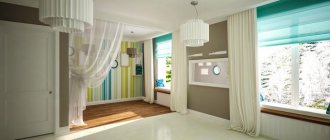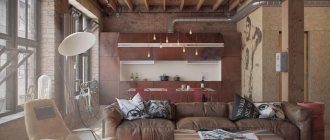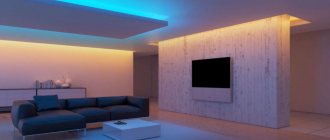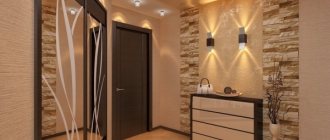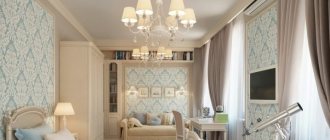Decorating a dressing room in the hallway, photo design
The hallway is an integral part of any city apartment or country house. The room plays a big role in creating the overall style of the interior and carries a certain functional load. An ordinary wardrobe cannot accommodate a huge number of personal items, seasonal outerwear or shoes, so the most popular solution is a dressing room in the hallway, design photos and useful recommendations are presented below.
Dressing room in the bedroom
Most people choose the bedroom to locate their dressing room. This is explained by the fact that it is more convenient to change clothes and select outfits here. The bedroom is the best place for a dressing room and many designers choose this particular room for this purpose.
If you also decide to settle on a bedroom, you should consider the following options:
- Designate a separate wall for the dressing room, covering the structure with doors or curtains.
- Organize a place behind the head of the bed. For this option, it is better to choose sliding mirror doors, since a bed moved to the center will take up a lot of space. Mirrors will help visually expand the space.
- If the room is too small, it is better not to cover the dressing area. Shelves should be placed asymmetrically and not too close to each other. This will give the impression of a separate interior composition, which will also perform a practical function. But this option is suitable for neat people who care about cleanliness and order.
- If the bedroom area pleases with large space, it can be divided into functional zones. A partition made of plasterboard will act as a dressing room, leaving the sleeping area untouched.
Advantages and disadvantages
A multifunctional wardrobe cabinet looks stylish, aesthetically pleasing and has many advantages:
- solidity - when creating a built-in storage system, it is necessary to correctly calculate its dimensions so that all elements fit tightly to horizontal and vertical planes;
- compactness - in a small hallway it is difficult to install pieces of cabinet furniture that have strict geometric shapes. Therefore, installation of built-in modules is the only option for arranging a small space;
- affordable cost - when installing a built-in wardrobe there is no need to create a frame, it is enough to make a facade, so the price is significantly reduced;
- leveling of surfaces - a dressing room made to individual sizes helps to visually level out small deviations; ready-made cabinet furniture, on the contrary, will emphasize the slightest irregularities.
For all their attractiveness, built-in products have certain disadvantages:
- impossibility of transfer - the storage system built into the hallway is made taking into account all architectural features, the structure is difficult to install in another area;
- the need for repairs - reliable fastening materials are used during assembly, after dismantling it is necessary to carry out minor cosmetic repairs;
- complex assembly - the arrangement of the dressing room should be carried out by specialists with certain knowledge and experience.
When choosing furniture for the hallway, you need to take care of the spaciousness and functionality of all design elements. Drawers, convenient wicker boxes with lids or plastic containers are perfect for various accessories and hosiery products.
It is better to place open shelves for storing everyday items in an easily accessible place; it is recommended to place seasonal clothes on the upper floors. It is recommended to install a special narrow pencil case with separate square compartments for shoes or boots. High-heeled shoes can be conveniently placed on metal hangers.
You can significantly increase the functionality of your locker room by using compartments for scarves, ties or belts.
A full-length mirror, a small couch or ottoman will help create the most comfortable conditions while changing clothes. There are many options for arranging a dressing room in the hallway; the design and photos are presented below.
Corner
The convenient configuration is ideal for corridors with a small area. With a well-designed project, you can most rationally place the underwear and clothing of all household members. A corner dressing room in the hallway is the only option for creating voluminous storage in a small apartment.
Inside the modular design, a spacious storage system is created: spacious open shelves, pull-out compartments, metal rails for clothes. To prevent the structure from looking cumbersome, it is necessary to alternate open and closed areas. A modern, functional dressing room will be an ideal replacement for a full-fledged dressing room. Spectacular mirror surfaces of the facade will help to visually expand the space of the hallway.
In a niche
An architectural niche is a good option that allows you to arrange a spacious, functional dressing room without any special financial costs without disturbing the unity of the entire space. A separate room must fully correspond to the overall style and color scheme of the apartment.
According to the method of opening, doors in a niche can be hinged, sliding, folding or swinging. Particularly durable door leaf is made from natural solid wood. For modern interiors, you can use glass, plastic, mirror or laminated surfaces. To prevent the built-in dressing room from turning into a storage room for a large number of unnecessary things, it is necessary to review all the contents from time to time and, without regret, get rid of clothes that have already become unnecessary.
Open type
In a small hallway, the dressing room can have an open space - this will create the illusion of a spacious area. But it should be taken into account that all stored items will be located in plain sight; it is necessary to constantly maintain perfect order.
The entire storage system consists of wooden dividing walls and spacious open shelves, the uppermost and lower compartments are closed with doors. Decorative boxes or elegant wicker containers are used to store small items. In open-type dressing rooms, designers recommend placing a comfortable couch or a soft ottoman along the entire rack with shoes or clothes.
An open dressing room is a natural extension of the room, so they are decorated in the same style.
Closed
The length and width of a closed storage facility depends on the size of the corridor. But even in narrow hallways, where there is very little free space, you can install a compact version of the dressing room. The advantages of a closed storage system are quite obvious: things will not gather dust or become dirty, and there is no need to constantly put things in order.
In addition, in a conveniently equipped separate room you can try on clothes, get ready for the theater or work. Designers advise hanging a large mirror or placing a dressing table, and an ordinary dressing room will turn into a toilet room.
To properly organize a separate room, you need to think about its location in advance. The ideal option is to take advantage of existing niches. In addition, you need to consider the ventilation and lighting system.
About the cons
Redevelopment is often required
Most often, developers do not provide sufficient storage space. Therefore, you can do without redevelopment only if you decide on a dressing room with a curtain or build a light structure from plasterboard or glass. The location and dimensions of a full-fledged dressing room must be planned already at the first stage of creating the project.
Open storage
If a small dressing room does not have lockable cabinets, then the clothes in it may become covered with dust.
Decor
The most luxurious and expensive dressing rooms in the hallway are made from natural solid wood. When creating an economical option, modern materials such as laminated chipboard or MDF are used. Compartment doors are made of wood or durable glass, baskets for storing small items can be made of plastic, wicker or rattan.
Small dressing rooms should be decorated in light bed colors. If there are no window openings in the room, care must be taken to create artificial lighting. To do this, you can use a ceiling chandelier or successfully illuminate individual areas of the dressing room. LED strip and small spotlights look very impressive. Modern LED light bulbs will create soft diffused lighting. A well-equipped dressing room will allow you to properly organize the space and create a convenient, functional and comfortable storage system.
Working on the lighting
The most convenient option is cornice lighting or ceiling lighting around the perimeter. Individual spotlights can be placed in areas that require additional lighting: in niches or above the dressing table.
Even in mini-dressing rooms, and even more so in large ones, ventilation is necessary: in a closed room, a musty smell quickly appears, which no perfume can mask. Therefore, even when planning, find a way to make ventilation in the dressing room.
The principle of its design is no different: in the upper part of any of the walls, preferably further from the door, an exhaust hole is made into which a fan is inserted. The inflow is provided either into the gap under the doors or into special inlet openings located just above the floor level. They are closed with decorative grilles.
Principles for organizing ventilation of a dressing room through a bathroom
When choosing a fan, you should pay special attention to the noise level. Since dressing rooms are often located in or close to bedrooms, noise should be kept to a minimum. It can be controlled automatically or turned on/off using conventional or walk-through switches.
The lighting should be bright. Firstly, this is necessary to quickly find things, and secondly, dressing rooms are often used as fitting rooms to immediately see how well the selected items fit together. The mirror is usually placed on the door or mirrored doors are made. In this case, the light should be directed not only to the shelves and storage systems, but also to the fitting area.
One of the lamp options
You can use lamps of any type, but it makes sense to make them turn on from motion sensors. They opened the doors - the lamps came on, there was no movement, they turned off. There is another option for swing doors: there are lamps with buttons that light up when the door is opened and turn off when they are closed.
READ MORE: Viola ampelous 36 photos growing at home How to plant seeds for seedlings Varieties Waterfall mix F1 and Summer wave purple Plenchifol F1 lavender blue and Wonderfall blue picoti shades
Arranging a dressing room in the hallway: simple options and original solutions
It is impossible to imagine a home, especially if it is an apartment in a multi-storey building, without an entrance hall. When creating a general interior, they do not bypass this room. The main task is to give it functionality. In some versions, one could see a wardrobe in the hallway. But its appearance did not always fit into the interior, and its capacity is questionable. One solution is a built-in dressing room in the hallway. How to arrange it?
How to make a dressing room in the hallway with your own hands
Nov 15 • Uncategorized • 97 Views • No comments on the entry How to make a dressing room in the hallway with your own hands
Contents
A dressing room is not only very practical, but also fashionable: everyone around will gasp when they see how carefully you treat your own things! Not every modern apartment has space for a full-fledged room for storing clothes, and many settle on a compromise option - a dressing room in the hallway.
Wardrobe options for the hallway
Before you start arranging your wardrobe, you need to think through all the nuances. First of all, we are concerned about the capacity and functionality of the design. They provide not only a wardrobe, but also other elements: drawers, boxes and plastic containers.
The use of a closet involves storing things both for everyday use and for seasonal use. Easily accessible open shelves are suitable for permanent items. The space at the very top of the wardrobe is reserved for items that are used less frequently.
It is recommended to consider a pencil case. It is ideal for storing boxes of shoes. For convenience and general decor, be sure to add a couch and a full-length mirror.
In addition to functionality, they think about the appearance and location of dressing rooms in the hallway. In this case, the layout of the room plays a significant role.
With swing doors
The installation of a dressing room in the hallway with hinged doors suits the classic style of the interior. Its dimensions directly depend on how much space the hallway allows. The original appearance is achieved through a variety of fittings.
By hallway size
The dimensions of dressing rooms for hallways directly depend on the free space. They can be small, or they can be a whole dressing room. Let's look at a few of their features.
Small wardrobe
If you have an apartment of standard sizes, in which the hallway is not very large, you can arrange a dressing room with an area of 4-5 m2. For residents of 2-3 people this is quite enough. With minimal dimensions, the dressing room in the corridor is reduced to an area of 2 m2, which by and large is no different from a regular wardrobe. The main thing is to rationally distribute the space.
Basic tips for organizing a small wardrobe:
- It is better to place it near the wall with the largest area.
- To save space, sliding doors are installed, preferably from floor to ceiling.
- The interior is filled with shelves, rails, shoe racks, baskets and boxes.
- Be sure to make sure that not a single square centimeter goes unnoticed.
- The shelves are placed right up to the ceiling. For ease of use, carry a stepladder.
If the design of the room allows, then you can also arrange a corner wardrobe in the hallway. The simplest option is to fence off the corner with a plasterboard partition and then install sliding doors. The shelves are mounted directly to the walls. This design has a triangular shape.
Let us also note the simplest option - an open mini-wardrobe. Occupies a small space near the door. Consists of a minimum of elements: a shelf for shoes, a rail with hooks and an upper shelf for hats.
Large wardrobe
In the case where there is a lot of free space in the hallway, a large dressing room is arranged. To do this, a wall is built from a plasterboard partition and a door is installed in the opening. Within the allotted space, you can experiment and distribute shelves, drawers and hanging rods at your discretion.
But to make everything look modern, it is recommended to listen to the opinions of experts:
- For a large dressing room, several rods are installed to store clothes on hangers. Their placement is carried out at different levels.
- The more drawers you can arrange, the better. They can be decorated in a different color. Recently, the arrangement of wicker or plastic baskets has become very popular.
- Shelves are an indispensable attribute. There should be a lot of shelves in the dressing room.
- To place shoes, there is a compartment that is narrow and high in appearance. It's called a pencil case. Shelves are installed directly in it.
- We should not forget about the placement of ties, scarves and other accessories.
- The highlight of the dressing room is the full-length mirrors and the presence of a soft pouf for convenience.
Dressing room in a one-room apartment: myth or reality?
Dressing room in a one-room apartment: myth or reality?
Each of us dreams of our own home, which will not only provide protection from all external dangers, but will also give us peace and comfort, which we are ready to work on. However, the imagination does not always paint us earthly pictures: and now a one-room apartment in the suburbs replaces a three-room luxury in the center of Moscow. Of course, the number of things and household items does not decrease from this, and the dressing room project, seen in the Construction and Repair magazine, does not give rest at night. What to do - be content with privatized meters and forget about design?
Dreams should not remain on paper! Let's look at several options for arranging a storage system in a one-room apartment using a high-quality and effective solution, which are Elfa wardrobes . So, let's start with the most, at first glance, difficult option:
Redevelopment - separate dressing room.
It’s no secret that the word “redevelopment” terrifies all owners and foremen. The reason for this is the simplicity of construction work, but the legal approval of all documents in government agencies. Another disadvantage is the voluntary reduction in the living space of the only room in which it was planned to place the old wardrobe. In addition, load-bearing walls often do not allow us to organize space in a way that suits us. Yes, there are many difficulties, but lately designers are increasingly choosing this option.
Indeed, a separate dressing room replaces not only a closet in the hallway, but also a wardrobe, a pantry and even a laundry room, freeing up space in the bathroom or kitchen. In such rooms, all household items are stored in a separate basket, stand beautifully on a shelf or hidden behind sliding doors, without dirtying the owners’ personal belongings. Everything is at hand! Needless to say, Elfa dressing rooms can easily be disguised as a built-in wardrobe , where a convenient and durable storage system is hidden behind sliding doors.
Niche – built-in wardrobes.
If you have a one-room apartment with a niche, consider that half the work is already done! Of course, the recess may be too small or located in a hard-to-reach place in the apartment - in this case, you cannot do without the advice of a designer. However, a standard niche can become either a closet in the hallway for outerwear or a storage room, depending on the location. It is convenient to fill such a small room with shelving and baskets from the Elfa catalog.
The room has a modern wardrobe.
If none of the previous options suited you, then we suggest you opt for a standard solution - installing a dressing room behind sliding doors, following the example of a sliding wardrobe. This step will give you a number of benefits! Firstly, the contents for the dressing room are varied, and you can develop an individual project. Secondly, the designer is not tied to strictly defined cabinet dimensions, allowing him to allocate only the necessary meters for the storage system. Thirdly, sliding doors with a variety of decorative finishes will fit perfectly into any interior.
The choice is yours. Appreciate and make good use of every meter of your apartment, and Elfa at Unimall shopping center and Sindika shopping center will try to help you with this!
Where to place the built-in wardrobe
The best option for the price is a built-in wardrobe option. Some of its advantages over cabinet furniture are also noted:
- reduction of elements, which significantly reduces the cost of the structure and simplifies installation;
- increased stability, so it is impossible to tip it over;
- solidity of the structure, since the back and side walls act as elements of the dressing room;
- The built-in wardrobe fits perfectly into any interior.
Such a cabinet is best built in large niches, or, if there are none, next to the wall with the largest area. If space allows, you can install it opposite the front door. In addition, in very spacious rooms, sometimes a built-in wardrobe can act as a partition wall.
Hallway design with dressing room
Everyone wants to have a spacious hallway with a convenient dressing room. But this is not always real. When creating an interior, you have to start from what you have. There are several design options for hallways with a dressing room. Ideas can be viewed in the photos below.
In addition to the structure and shape of the dressing rooms, their design is important, which can be supplemented by the following variations:
- accessories, the variety of which is not decently large;
- the presence of mirrors with different decorations;
- variety of lighting: spotlights, LED lighting, etc.
There are quite a lot of examples. You can view them on the Internet in photos and, if desired, create your own individual project. You can also contact designers who will definitely give practical advice.
What to consider when choosing a dressing room and wardrobe (2 videos)
Features and Benefits
A wardrobe can be an entire room or a small closet. In both cases, it has a number of its own features and advantages:
- Compactness. A small, neat wardrobe can fit even in a very modest-sized hallway. Most often, built-in models are used for this purpose.
- Availability. The modern variety of construction and finishing materials makes it possible to create very inexpensive models that will not put a big strain on the family budget and, at the same time, will cope perfectly with the tasks assigned to them.
- Convenience. A wardrobe is a place for simultaneous storage of a variety of things (clothes, shoes, gloves, hats, umbrellas, bags). It is much more convenient when all these items are in one place, and not laid out on different shelves, cabinets, racks, as is often the case.
In addition to these things, it is quite possible to store household and sports equipment in the wardrobe.
The advantages of a dressing room are:
- Aesthetics . Thanks to the work of designers, today every person has a unique opportunity to beautifully, originally, creatively decorate their hallway with a piece of furniture that also performs a significant functional load.
- Practicality. Wardrobes are usually made of very strong, durable, wear-resistant materials that do not require too much maintenance.
- Room adjustments. A built-in wardrobe is the ideal solution for filling a niche or small storage room that was not intended to be used in any other way. A wardrobe can perfectly disguise unevenness and imperfections in a wall. A mirror decorating a furniture façade will add light to a small room and visually expand it.
In addition to the advantages, there are several disadvantages:
- Impossibility of moving the built-in wardrobe to another place;
- Complexity of installation (built-in model);
- Despite its compactness, the wardrobe takes up enough space. This is especially noticeable within a narrow or small corridor.
Wardrobes may differ from each other in several ways (configuration, size, design, content, material, decor).
Corner dressing room
This option is most often used in small hallways. Often it is the only optimal option for arranging a Khrushchev corridor, for example. Well-thought-out internal filling allows you to carefully and most efficiently place the clothes of all household members.
To prevent the structure from looking too bulky, the internal system should combine open and closed modules, compartments, drawers, and shelves.
Open dressing room
Open dressing room. It is used for hallways of different sizes, but is preferable for small rooms. One of the advantages of this design is the feeling of free, bright space.
However, do not forget that all things and clothes will always be open to prying eyes.
This system consists of wooden or plastic shelving, spacious open shelves (there may be several shelves with doors in the lower part), wicker baskets, and drawers. Along the shelves or drawers with shoes you can place a small soft sofa or pouf. Very often, an open-type dressing room is a smooth continuation of the room, and therefore is decorated in the same style.
Closed dressing room
This storage system looks ideal in spacious rooms. The wardrobe can be very small or have several sections isolated from each other. The advantages of this type are obvious - things are laid out in a neat order, hidden from prying eyes, and dust does not fall on them from the outside.
If a closed dressing room is not just a closet, but an entire room, then it will be convenient to try on a new outfit or change clothes. The dressing room can be equipped with hinged or sliding doors.
The first option looks perfect in a classic interior. Of course, swing doors require a lot of space, but they can be given an original and stylish look with the help of interesting decorative items or beautiful fittings.
Sliding doors do not “eat up” space, are easy to use, and their wide, even and smooth surface can become an excellent basis for various decor options.
Built-in wardrobe
A built-in dressing room has a number of advantages over cabinet counterparts. Among them:
- The cost of the structure is significantly lower due to the saving of material on the frame, which is often replaced by the walls, ceiling and floor of the pantry or niche itself.
- Sustainability. It is impossible to knock over a niche, which cannot be said about a free-standing cabinet.
- Feeling of a holistic, monolithic structure. All wardrobe elements are very tightly adjusted to each other and to the room itself. In addition, a wardrobe located in a niche or closet visually enlarges a small space.
- Organic. The built-in dressing room fits perfectly into any interior.
- Optimality. An option with a built-in dressing room can sometimes be the only option for a room with a complex architectural form.
There are few disadvantages, but they exist:
- It is impossible to use a standard design (built-in wardrobes are made individually for a specific niche size);
- Difficult to install and assemble.
Dressing room in the hallway: types and features of choice
A dressing room is a rational way to solve the issue of compact placement of things. It ensures the safety of clothing and shoes when they are not in demand for a long time, and allows you to keep things that are used daily in perfect order. Thanks to a wide selection of modifications and designs, the dressing room will harmoniously fit into the interior and layout of any hallway.
Advantages of a dressing room in the hallway
The hallway is a traditional place for a dressing room. And this is quite logical - after all, if it is necessary to go outside or, conversely, upon returning home, the owners will not have to exercise throughout the house in order to put on the appropriate clothes. At the same time, the room always looks neat: outerwear is hidden, there is no need for additional shelves, drawers for storing shoes and other furniture elements.
The dressing room often stores items that usually have difficulty finding a place in the house, for example:
- items for tourism and sports;
- household equipment (mop, brushes, etc.);
- working tools, household appliances;
- seasonal items - in the dressing room you can hang a fur coat or coat for the entire warm period without fear of safety.
An additional bonus is that it can be used to easily hide an electric meter or alarm remote control.
Taking into account the load, wardrobes in the hallway are usually made of durable and strong materials. Therefore, by purchasing them, you can be sure that you are making a long-term investment in the comfort and convenience of your home.
Types of dressing rooms
When developing dressing rooms, a wide range of layouts, square footage and consumer requests are taken into account. Therefore, the buyer is offered several solutions, one of which will certainly suit his taste.
Corner
Such models are well suited for small hallways. They are distinguished by maximum thoughtfulness, which allows you to neatly place the belongings of all the inhabitants of the house. A combination of open and closed modules will help avoid the feeling of excessive bulkiness. A type of corner dressing room is radius (with rounded cabinets). The design looks very impressive in advertising photographs, but you need to remember that such a solution can only be applied to spacious corridors.
Open
They are a system of racks and open shelves, partially or completely devoid of façade elements. Often the design includes wicker baskets and boxes. The lower and upper compartments can be closed, but the central one always remains open.
This type is an excellent solution for small spaces, although they fit well into the surroundings of a spacious hallway. The structures externally expand the space; they are often used to decorate the transition from the living room to the hallway. Therefore, it is advisable that the dressing room matches the style of the room. When choosing this option, you need to carefully consider whether you are ready for your things to be constantly open for viewing.
Closed
It is better to take closed options into rooms where there is enough space. They can consist of several small modules or be a separate room where one person can easily fit. The positive side of the closed variety is that they protect things from dust and from prying eyes.
Closed models may have hinged or sliding doors (wardrobes). The latter allow you to save a little extra space. In addition, in sliding wardrobes, the doors are sometimes made mirrored over the entire height of the product, this allows you to avoid spending money and effort on purchasing and placing a separate mirror.
Some designs do not exceed 40 cm in depth, which allows the use of such dressing rooms in the corridors of classic “Khrushchev” buildings.
Built-in
If the room has a niche or storage room, a built-in dressing room will be a great way to make good use of their space. Among the advantages of such a solution are:
- savings - the frame is replaced by walls, floors and ceilings, which significantly reduces the cost of materials;
- increased capacity - all elements are adjusted to the room and to each other, every square centimeter is used, this allows you to place much more necessary things in such a design;
- variability of design solutions - the dressing room is designed in accordance with the customer’s requests, which allows it to organically fit into any interior style;
- preservation of free space - furniture is “recessed” into the wall or built into the closet, without taking away extra meters from the corridor;
- safety – the absence of protruding corners eliminates injuries due to careless movements.
The disadvantages include the inability to use a standard design, which somewhat delays the start of operation after ordering.
Wardrobe in a small hallway
Modern wardrobes can be of completely different sizes, configurations and appearance. Therefore, it will not be difficult for home owners to choose the best option for themselves, including for a small apartment. A miniature wardrobe or built-in model will help you rationally use every millimeter of space in a small room.
For small hallways, the following models are preferred:
- wardrobe - suitable for narrow corridors, as they are of small depth;
- corner model of rectangular design - will allow you to use an often unclaimed corner;
- built-in structures - will allow you to rationally use a niche or storage room, avoid the presence of protruding elements and save a lot of usable space
With limited space, it is better to make a wardrobe from floor to ceiling. If you order the production of such a design according to individual standards, this will allow you to use the full potential of the area allocated for the wardrobe. For greater convenience, get a stepladder or stand - then you can easily get things from the highest shelves.
A few simple rules will help you visually increase the area:
- mirrors on the facades will visually expand the walls and raise the ceilings, filling the room with light;
- completely closed models “pressure”, seem too massive, emphasize the lack of space, open ones in small rooms look more airy, but create a feeling of disorder, so it is better to use combined options;
- swing doors when open can make it impossible to move in a narrow corridor; sliding structures are more suitable here;
- Light colors are also preferable to dark ones; if the interior allows, take light but non-staining shades.
For a family of three or four people, the optimal size of a dressing room is about 5 square meters. m, in very small rooms you can limit yourself to 2 square meters. m. A good option is a mini-wardrobe, which is a small open system for storing essential items.
Organization of space in the dressing room
The arrangement of a dressing room in the hallway is dictated not by whim, but by the requirements of necessity. Therefore, it is very important when choosing to proceed from practical tasks: it should not stand out from the rest of the room and not interfere with movement, but at the same time have maximum functionality.
A structure can fully perform its functions only if its internal space is rationally organized. To do this, you need to plan in advance the location of all its elements and the placement of things in them.
Despite the variety of solutions, there are several basic principles that should be used:
- first, the location of large compartments for clothes is determined, the remaining voids are distributed under drawers, shelves and baskets;
- The depth of the shelf should not exceed 1 meter; if more spacious options are provided, they should be retractable;
- the hanger rod cannot be longer than 1.2 meters, otherwise it will sag under the weight of the clothes;
- to accommodate things of different lengths, it is necessary to secure several rods at different heights;
- comfortable movement between racks is possible only if a passage of 60 cm is provided, and if there are drawers - 110 cm;
- internal surfaces should be easy to clean from dirt, because they can be dirty by umbrellas, outerwear or shoes that will be placed there;
- the wardrobe or dressing room area should be provided with high-quality lighting so that household members can easily find any item at any time of the day;
- In order to maintain a presentable appearance and proper condition of seasonal items, it is necessary to take care of proper ventilation in advance.
When placing items, ensure that currently in-demand and seasonally appropriate items of clothing and footwear are easily accessible. Move the rest of the clothes deeper.
Store shoes in shoe racks or in boxes on shelves. For shirts and blouses, use a hanger chain to save a little extra space. To keep your socks and underwear drawers organized, use dividers.
Internal filling
There are two types of dressing rooms according to their internal contents: frame and panel. The first ones are a frame made of metal posts onto which the elements provided for by the project are attached. Thanks to the large number of holes for fixation, elements can be easily replaced with others, swapped, and installed at the desired height. In addition, frame structures can be easily dismantled and reassembled in another location.
Panel options are less mobile. The modules in them are attached to a panel fixed to the wall or standing next to it. Such dressing rooms look more status and solid. Usually made from veneered MDF or solid wood.
For convenient placement of things and objects for various purposes, the design of the wardrobe should provide a basic set of functional elements:
- trousers - devices for storing trousers;
- pantographs - devices that allow you to use the upper space of a wardrobe closet, placing seasonal items there, and provide ease of use in the lower zone; with their help, you can lift up to 20 kg of clothes to the ceiling;
- classic rods placed at different levels;
- drawers, baskets and shelves for storing bedding and underwear and things that can be stored folded;
- sections for storing household and sports and tourist equipment;
- hangers for accessories.
Traditionally, the lower zone is used for shoes, and the upper zone is used for hats or bed linen. One or two central sections are reserved for outerwear.
Ideas for arranging dressing rooms can be found on the Internet, including on our website. Our catalogs contain photos that will help you navigate the variety of products and finally decide on your wishes and requirements for a new wardrobe.
Materials
Today there are practically no restrictions on the choice of materials for creating and decorating a dressing room. These can be budget and luxury options for every taste and budget. Among the most used materials today: laminated chipboard, MDF, natural wood, metal, plastic, glass, mirror.
The most original looking models are those made in a combination of several materials of different textures, for example, wood and glass, plastic and photo wallpaper.
Wood is an excellent natural material that has long been very popular in the construction and decoration of houses, furniture creation, and interior design. Today, few people prefer to use solid wood to create wardrobe spaces, choosing more budget-friendly materials.
However, it is almost impossible to replace noble, beautiful, durable, “living” wood with its unique smell and healing properties.
Dressing rooms made of solid oak, beech, alder, ash, pine, maple are made to order. Such models have a number of advantages:
- Strength, durability;
- Excellent decorative properties;
- Environmental friendliness, safety.
Wood is a very malleable material. It can be used to create the most architecturally complex structures and carved decorative elements. It looks great in its natural form and is suitable for painting, pasting, tinting, and artificial aging.
A wooden wardrobe in any interior looks appropriate, expensive and dignified.
Types of dressing rooms
There are several main varieties.
Wardrobe in the hallway
Multifunctional, practical and mobile furniture, which, if necessary, can be moved to another place and thereby model the interior in a new way.
The photo shows a white wardrobe with hinged doors in the hallway in the interior of the house.
Built-in dressing room in the hallway
It has a holistic and monolithic appearance. An organic design built into a niche or closet allows you to save useful space in the room. In addition, such a dressing room will be the best choice for a corridor with a complex architectural shape.
The photo shows a corridor with a wardrobe built into the pantry.
Corner dressing room in the hallway
Trapezoidal, triangular or radial modular products are equipped with spacious shelves, drawers and crossbars for things. To prevent the design from looking cumbersome, it is appropriate to install a completely open or combined type of wardrobe. Designs with mirrored facades will help to visually increase the area of a small corridor.
Particularly noteworthy are semicircular products, which may have a concave, convex or wavy shape. Radius models look stylish, modern in appearance and add special sophistication to the interior.
The photo shows a corner dressing room in the design of a modern hallway.
Open dressing room
It is made in the form of wooden, metal or plastic racks, equipped with rails, baskets and hangers. Such a storage system takes up a minimum of space, gives the corridor a light look, but always needs to be in perfect order.
The photo shows a corridor in the interior of the house, equipped with an open wardrobe.
Closed wardrobe
It may be small in size or equipped with several isolated sections. This type of wardrobe allows you to neatly store things, hide them from prying eyes and protect them from dust. The design is complemented by doors, which are decorated with beautiful fittings, mirrors and other decorative details.
The photo shows a closed dressing room with sliding doors in the hallway interior.
The subtleties of arranging a dressing room in a niche
What are the subtleties of arranging a dressing room in a niche? What is the main advantage for small apartments?
The subtleties of arranging a dressing room in a niche
Proper and careful storage of things is one of the most common problems of modern man. Most people have a lot of things that need to be stored somewhere.
The best option for storing things is wardrobes. Their main advantage is that they are very spacious, and they can be used even in small apartments.
One of the most common options is to arrange a dressing room in a niche. A niche allows you to rationally use all the free space available in an apartment or house. There can be several such niches in an apartment or house, and each can be used as rationally as possible - by arranging a dressing room, a closet for children's toys, etc. Even if there is no suitable niche, you can create it yourself or call a specialist - in fact, this is not labor-intensive work and it does not require much time or money.
Features of arranging a dressing room in a niche
In small apartments there is not much space, so using bulky cabinets in this case is not entirely correct. They take up a lot of space, and dust and dirt often accumulate on open shelves, so you need to regularly monitor things. In addition, high-quality cabinets cost a lot of money, so not everyone can afford them.
It is much more correct, economical and convenient to use a niche for arranging a dressing room. Some apartments with unusual layouts already have such niches, and they are rarely used. Therefore, the dressing room in them will not take up any space at all. If there is no niche, then you can make it yourself from drywall. Arranging a dressing room in a niche can be divided into several main stages:
- Choosing a suitable location. This should be a space that is not used or is used extremely rarely; this is the so-called dead zone in the apartment.
- Decide on the filling of the dressing room and choose suitable storage systems so that all things fit.
- Calculate the area of the future room and allocate the necessary space.
- Install a plasterboard niche, arrange the interior space of the dressing room, and install doors. The best option is sliding door systems, as they do not take up extra space.
A wardrobe in a niche is not only convenient and practical, but also very fashionable. Even those who have enough space in their home equip such cabinets for storing things, because this is a great way to diversify a modern interior.
Where to place it?
A dressing room in a niche of the room looks very attractive and does not take up much space. These are the main advantages of a dressing room in a niche. If you want to make one, you need to know and follow some recommendations that will help you create a dressing room in an apartment in a niche quickly and without much difficulty.
First of all, it is worth remembering that a niche for a dressing room does not have to be located in the hallway, as many people think. This can be any free space in any room. Often a niche for a dressing room is located in the bedroom or even the living room; the main thing is to correctly design the external design. Doors to wardrobe niches can be made of different materials, so that they take up minimal space, you can choose mobile sliding doors or an “accordion”.
Wardrobes in a niche of a one-room apartment can even become a highlight in the interior, and not just simply perform their main function.
What to consider?
How to make a dressing room in a niche so that it is spacious and practical, in harmony with the overall interior design? In fact, there is nothing difficult about this. Before arranging, estimate the area of the niche and carry out all the calculations. Also pay attention to the following parameters:
- the color should be in harmony with the rest of the interior or, conversely, be contrasting and stand out against the general background;
- facade - here you can use absolutely any materials, for example, the design of a dressing room in a niche can be classic or more modern, you can use mirrors in the design, which will visually help increase the size of the room;
- dressing rooms in a niche can also have any content - here you can place shelves and drawers, equip hangers and hooks, make shelves for shoes - everything depends only on the wishes of the owner.
If the dressing room is located in a niche in the hallway, you should make sure that there is enough space for outerwear and shoes.
A wardrobe system in a niche is an excellent option for saving space and using it rationally. You can use several recommendations to help visually expand the space:
- installing mirrors on doors is a universal and simple way to expand space;
- stained glass windows - not suitable for any interior, but if you think through all the details correctly, stained glass inserts will make the room very original and designer-complete;
- glass with photo printing is an expensive design option, but it easily fits into any design, looks great and visually enlarges the room.
There are many tricks when decorating a niche in a dressing room, so it’s worth considering them all and choosing the most suitable option for yourself.
Advantages of a dressing room in a niche
A wardrobe built into a niche has a huge number of advantages compared to conventional wardrobes. A dressing room in a hallway niche or in any other room has the following advantages:
- Using a minimum amount of space, so you can arrange such a dressing room even in a small apartment;
- They have good capacity;
- They look stylish and interesting;
- You can place things depending on how often they are used;
- Flexibility in designing structures and elements of storage systems;
- Easy to modify; if necessary, storage systems can be rearranged, supplemented or removed;
- Easy access to any things.
How to make a dressing room in a niche of a room? There is nothing complicated, but if you do not believe in your own abilities, you should turn to specialists who will help you create a project and make the dressing room of your dreams - practical, comfortable and beautiful.
We hope that our article was useful.
You can view and select elements and accessories for your dressing room on our website.
Hallway layout
In some projects of spacious corridors, the wardrobe can be separated by a false plasterboard wall and a door can be installed. This way you can create a separate dressing room in the hallway.
For a long and elongated room, a built-in model located along one wall is mainly used.
Organizing a wardrobe near the front door has significant advantages. This option makes changing clothes more convenient and eliminates the need to carry clothes across the entire apartment.
The photo shows the interior of a narrow modern hallway with a wardrobe built into the wall.
In a hallway that has a non-standard shape and has beveled corners, beams, various protrusions, etc., it would be appropriate to place a built-in wardrobe, which, unlike rectangular cabinet products, fits more organically into the space and saves square meters.
The photo shows a built-in wardrobe in a niche in the design of a small corridor.
The photo shows the interior of the corridor with a wardrobe located in the pantry.
LiveInternetLiveInternet
They say that the hallway is the face of the owner, because it is it that creates the first impression of the apartment and the inhabitants living in it. Therefore, regardless of size, the hallway should combine beauty, comfort and convenience at the same time. To fit everything you need in a small hallway and at the same time leave a feeling of air and open space, you need to use ingenuity and resort to some tricks. This article contains tips that are useful to consider when creating the design of a small hallway. To begin with, in a small hallway you need to clear the space - get rid of overhanging mezzanines and bulky cabinets. Next, you can think about architectural ways to enlarge a small hallway. For example, is it possible to make a niche in the wall of a room adjacent to the corridor? Through openings in the form of false windows or walls made of glass blocks add space. It might make sense to get rid of some doors to the rooms or kitchen and change the size and configuration of the doorways. When coming up with the design of a small hallway, last but not least, you need to think about lighting. The more light, the more spacious the room seems. In a small hallway, in addition to overhead lighting, it is good to use sconces, lighting, and floor lamps. This will make the corridor much more interesting and visually add space. When choosing finishing materials for a small hallway, it is better to exclude opaque textures, such as 3D plaster or wood. It is also better not to use wall panels, they “eat up” space. But you should pay close attention to textures with a glossy and reflective surface, because they help to visually enlarge the space. Since the hallway is the most polluted room in the house, all finishing materials should be easy to clean. If for some reason you decide to use paper wallpaper, then it is better to buy it with a reserve, so that in case of contamination you can replace a damaged piece. In the design of a small hallway, color plays a huge role. Traditionally it is believed that the lighter the color in a small hallway, the better. But there is no need to be afraid of experiments. Bright rich colors or successful catchy ornaments can turn your hallway into an original “box” and then the size will not matter much. Although it is better to make the ceiling light in any case, this will visually increase the volume of the hallway. In order to visually make a small hallway much more spacious, you can move the flooring that is used in the corridor beyond its boundaries - to “go” a little into the territory of neighboring rooms. Another trick is to install two mirrors on opposite walls. Under the mirrors, so. From the furniture in a small hallway, you need to install only the most necessary items - an open hanger, shelves for shoes and handbags, an umbrella stand, a mirror and a pouf. A sliding wardrobe in a small hallway can only be present in a niche. Although, if space still allows, instead of a hanger, shelves for shoes and a mirror, you can install a wardrobe without a special back wall and with sliding mirror doors. This closet allows you to save some space and looks like a built-in one. When creating the design of a small hallway, you need to think carefully and wisely use every centimeter of precious space. This is especially true for corners and narrow walls between doors. In such places it is good to install small shelves for bags, gloves and keys. To save space, the role of an ottoman can be given to a shoe rack. And despite the small size of the hallway, we should not forget about such things that are pleasing to the eye as stylish decorative elements. A framed photograph, painting, collage or panel will add zest to the interior of the hallway and emphasize its unique style.
Where is the best place to place it?
The dressing room in the hallway can be arranged in different places. The location will depend on the area of the room, its planning features and design, as well as on the size of the wardrobe itself.
Dressing room in the hallway niche
Many corridor spaces initially have recesses and recesses in which it is appropriate to arrange a stylish homemade locker room. The wardrobe in the niche is designed in accordance with the surrounding interior. It is left open or complemented with hinged, sliding or folding doors. Select panels made of wood, plastic, glass, or install doors with a mirror or laminated surface.
The photo shows an open dressing room in a niche in the hallway interior.
In the corner of the hallway
Most often it represents the most optimal solution for the corridor in a Khrushchev apartment. Thanks to properly thought-out internal filling, this design can accommodate the clothes of all family members. A design with the letter p or g, a semicircular or trapezoidal model, will fit perfectly into the corner space.
Dressing room along the corridor wall
It is appropriate to place a large wardrobe near one wall in the hallway. A universal option in the hallway is a narrow dressing room in the form of a rectangular rack for outerwear, shoes and hats.
The main requirements for the interior design of narrow corridors
A narrow room is arranged according to a number of rules:
- Multifunctionality is important for furniture in the hallway. Thanks to this, it will be possible to remove clothes, shoes and other household items from view.
Pay attention to wall cabinets with compartments for storing small items and shoes, this will rid the space of clutter
- In a narrow room, only neat furniture with a minimum of details should be used. The accumulation of a large number of small objects that significantly clutter up the space is not allowed.
Give preference to neat, uncluttered furniture
- It is recommended to adhere to minimalism. The style provides for harmony in the arrangement of furniture and the design of walls. In this case, you will have to give up unnecessary items.
Hallway in minimalist style
- Each person has his own vision of arranging space. It should also be paid attention to and taken into account when planning.
A minimum of furniture and interesting finishing details will make your hallway sparkle with interesting colors.
- The optimal solution for a hallway is a wardrobe. It takes up little space but can hold a lot of things.
Sliding wardrobe is an excellent solution for a narrow hallway
- If the hallway is too narrow, it is recommended to install a hanger or a narrow closet. Massive furniture will negatively affect the perception of space.
If a full-fledged closet does not fit, it can be replaced with hooks or a hanger for outerwear
You can place additional hooks for outerwear directly on the doors of the built-in closet
Features of internal filling
The upper tier is occupied by hats, the middle section by outerwear, and the lower segment is distributed for shoes.
The main functional parts are rods or pantographs, as well as elements in the form of drawers, shelves, baskets, pull-out pants, skirts and special sections for household supplies.
The photo shows an option for the internal equipment of a dressing room built into a spacious niche.
The wardrobe is often equipped with shoe organizers, hanging baskets for accessories, belt holders or even a built-in iron holder.
Thanks to various accessories and fillings, it is possible to simplify the operation of the dressing room and encourage the maintenance of perfect order in it.
How to decorate a dressing room: design ideas
There is an unlimited number of both budget and luxury materials that allow you to create a stylish and original wardrobe design. The most popular solution is to use laminated MDF or chipboard, natural wood, metal, plastic and mirrors.
Mirrored facades are unique and can not only decorate the hallway, but also adjust its volume and level of lighting.
Inserts made of bamboo or rattan will add naturalness and a natural character to the interior. Designs that are complemented by photo printing with a variety of images that match the overall interior style look very advantageous.
The photo shows the interior of a hallway in an oriental style with a wardrobe, decorated with inserts.
A wardrobe with a glass facade decorated with painting, film stained glass, fusing, beveli, batik or fresco will look truly interesting and unusual.
A wardrobe in a classic style can be decorated with carved details, skirting boards or pilasters. For doors, patination and gilding are used, and special mesh is used to create an aged effect.
The photo shows a corner wardrobe with a glass matte facade decorated with drawings.
What to do if the hallway is small?
In a small corridor it would be appropriate to place the structure at an angle. For this purpose, a product in the form of a corner wardrobe or a rack with combined closed and open shelves is suitable. In some cases, the corner can be fenced off with a plasterboard partition and a doorway can be installed in it. This will create an ergonomic triangular-shaped wardrobe.
For a small or narrow hallway, arranging a wardrobe near a long wall is also suitable. Sliding compartment systems from floor to ceiling are installed across the entire width of the wall plane. The interior space is equipped with shelves, rails, baskets, shoe racks and more.
The photo shows a small hallway with a built-in closed wardrobe.
There is a mini-wardrobe, which is a compact open structure for storing the most necessary things, which is mainly located near the entrance. A small dressing room in the hallway includes elements in the form of a shoe rack, hangers or hooks, as well as shelves for hats.
About the advantages
We save space in living rooms
A separate storage room will allow you to avoid cluttering up already not particularly spacious rooms with cabinets and other storage systems. Even in a one-room apartment with a layout that does not allow you to allocate part of the hallway for a dressing room, you can sacrifice part of the living space. It is better to put a chest of drawers in the room for linen, and move the main clothes to the dressing room.
Maintaining order
It is more convenient to store and sort clothes if they are collected in one place. Ideally, you can iron in the dressing room.
Save time on getting ready
It’s more convenient to change clothes - quickly and privately - here, when all the clothes are at hand. In addition, if you don’t change clothes in your rooms, there will be less dust there.
Filling the space to the maximum
The space of the dressing room can be filled as much as possible with storage systems, using the entire height of the walls.
And using a mobile clothes rack will allow you to use the entire perimeter, because if necessary, the rack can be moved.
We will equip it gradually
Outfitting a walk-in closet can be less expensive than buying built-in or pre-built cabinets. In addition, this room can be equipped gradually. You don’t have to put up a stationary wall or install a door, but separate the dressing room from the main room with a thick curtain on the ceiling cornice. This technique will allow you to maintain natural ventilation; textiles will add comfort to the interior.
We also use it as a utility unit
In a separate, albeit small, dressing room, you can select a utility unit and store large and bulky items for which it is difficult to find a permanent place in the house.
10 American interior items that are missing in our homes
